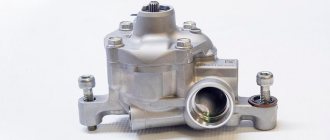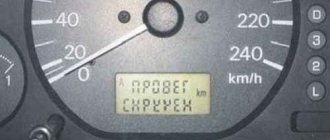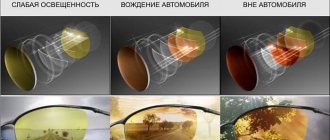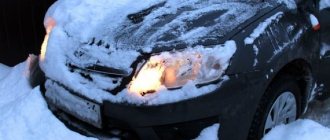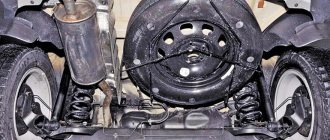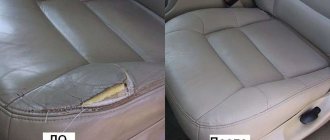Hold the steering wheel correctly
Oddly enough, correct taxiing, or rather correct holding of the steering wheel, will help prevent an emergency situation or get out of it competently. While driving, you should not “hang” on the steering wheel, using it as a support. In this position it is very difficult to quickly turn it in the right direction. The correct body position would be when your back rests against the back of the chair, and your wrists are located on the rim of the steering wheel. This position will help to effectively resist the force of inertia that occurs when the machine moves.
How to drive properly in winter: expert advice
Winter time is met by car enthusiasts in different ways. Experienced drivers are not too worried about this, active “drivers” rejoice at the opportunity to effectively slide in deserted turns, and beginners are excited, anticipating the difficult process of gaining new experience. But they all have one thing in common: the need to understand the correct winter driving technique. Ivan Chuzhmar, a defensive driving coach, told us about how to drive correctly in winter, how to protect yourself and your car, and what can help with this.
The material was prepared in collaboration with NITTO TIRES.
Morning exercises
Snowdrifts are the first thing a driver may encounter on a frosty morning. The best way to get out of this captivity is definitely to clear the path in front of the car. If you didn’t have time to buy a shovel, you can push the snow away with your foot or a mat from the car, after loosening the snowdrift with a sweeping brush. This will be more time-consuming, but cheaper than replacing a bumper or radiator.
If you are not worried about the bumpers, and the radiator is high and deep enough, you can roll out the snow with the car itself, pushing and compacting it back and forth. However, I strongly advise against doing this if the snow has hardened. Therefore, you need to take care of leaving in the morning in the evening, having thought about this departure for yourself and looking at the weather forecast. Maybe in the winter it’s worth setting your alarm clock 20 minutes earlier so that you can do some leisurely morning exercise in the fresh air.
We drive correctly
When talking about winter driving, it’s worth starting with something simple – with the main differences between winter driving style and summer driving style. have already written about basic things like warming up and the features of driving in winter clothes , now you can move directly to driving on the road. In summer everything is clear: the asphalt is dry and hot, and the tires have maximum grip on the surface. In winter, even in the absence of snow, the asphalt temperature is low, and the coefficient of adhesion of cold tires to a cold surface is not nearly as high, which means the braking distance will be noticeably longer.
Speaking about winter asphalt, it is worth noting that its appearance is often deceiving. It seems that it is just wet or a different color - but in fact, it is covered with ice. And only after feeling the beating of the brake pedal, indicating that the ABS has worked, does the driver realize that it is slippery under the wheels. Therefore, even on asphalt free of visible ice or snow, you should start braking earlier than you are used to doing in the summer - cold wheels and brakes work differently.
When driving on a winter road, you should take into account the sharpness of the steering wheel. If on asphalt reckless movement would be simply risky, then on ice it can cause the car to skid. A similar result can be caused by releasing the gas during a turning arc: destabilization of the car and uncontrolled sliding, which, as a rule, is aggravated by immediately pressing the brake pedal to the floor. It is also worth understanding that pressing the brake a little more sharply than necessary when driving in a manual transmission gear can shut down the engine - and the further scenario of driving a stalled car without power brakes and steering wheel has every chance of becoming disastrous.
In an effort to accelerate most dynamically on a winter road, you should not use traditional summer techniques. It is worth remembering that whatever the road, the dynamics depend on the coefficient of adhesion of the wheel to the surface. If slippage occurs during acceleration, the grip practically disappears - therefore, the less slippage, the faster we accelerate. And since it is much easier to turn a wheel on ice than on asphalt, in winter you should be much more careful with the accelerator pedal.
Both in summer and winter, when driving in a turn, you must follow basic rules. So, the visible part of the road should allow you to stop without using emergency braking - which, in turn, depends on the surface, tires and condition of the car. If you want to go faster, a smooth and moderate addition of gas in a turn is not prohibited - that is, the speed at the exit of the turn may well be higher than at the entrance. However, in the dark, you need to move at such a speed that the braking distance is in the light of your own headlights: if you skid, there will be no desire to turn into the dark.
The main thing when braking in winter is that it be smooth, so that the braking itself does not provoke the car to slide. If you have a modern car equipped with many electronic active safety systems, then their operation should be taken as your fault. There can be many reasons for this - a sharp press on the pedal, a place or moment of braking... But the essence, in any case, is the same. Well, from the point of view of the correct algorithm, the optimal braking technique is when the driver brakes before turning the steering wheel, and not during the turn itself, and moves in an arc at a constant speed, without additional braking.
Preventing skids
The most common situation when driving on a slippery road is skidding. It can be triggered by entering a turn too quickly, sharply turning the steering wheel, or sharp braking. To prevent skidding, you need to be as attentive and collected as possible, and think through all your actions in advance.
If a skid does occur, then you need to act based on which wheels in your car are driving. The technique for getting out of a skid is different for rear- and front-wheel drive. In any case, in order to get out of a skid on a slippery road without loss, you need to have emergency driving skills, which can be obtained at a driving school.
Tire selection
Choosing the right tires is a crucial moment. It is strictly forbidden to deviate from the manufacturer’s standards, since any deviation may affect traffic safety. When buying tires, be guided by three conditions.
Characteristics of the type “European” and “Scandinavian” tires. The first type has water-repellent properties that will prevent hydroplaning and has good traction. The second type is more suitable for icy roads.
Type of pattern: symmetrical and asymmetrical. The first one has a low cost, produces noise when driving and is suitable for city roads. Rubber with an asymmetric pattern copes with its task more effectively.
Dangers of a snowy road
Driving on a snowy road also has its own characteristics. For example, after a long descent, even a small gentle climb seems quite steep, and smooth turns look very sharp.
In low light conditions, the road often does not look wide enough. Because of this, many drivers, when passing oncoming traffic, sharply turn the steering wheel, trying to avoid an imaginary collision. It is worth considering that this maneuver is fraught with an accident.
Regardless of the situation on the road in the winter, the most important thing is to remain calm and self-controlled and be attentive. Then your journey will be smooth.
Features of winter driving
How to park?
In winter, it is better not to park close to a curb or other cars. In the first case, you will probably get stuck, since snow accumulates near the curb, which you can easily drive into from acceleration, but will not be able to leave due to slipping. In the second, no one is safe from slipping, which in a tight parking lot can be fatal, and you will hit someone else’s car.
It is not advisable to park on slopes, but sometimes there is no way out. In this case, you should stop in such a way that the rear of your car is necessarily higher than the front end. To roll back when exiting, it is better to stand in front of the direction of travel on the descent, and opposite on the ascent.
Start
Start of movement
It’s easy to get going in the summer, but winter driving has its own nuances. You need to start exclusively at low speeds, very carefully releasing the clutch pedal and slowly pressing the accelerator. Moreover, this rule applies not only to snowdrifts and open ice, but also to sections of the road that seem clear, because an ice layer often forms on them. So it’s better to stall than to start grinding the road with your wheels.
Video: How to drive in winter
Slipping is fraught with uncontrolled lateral sliding of the car, no matter whether the car is front- or rear-wheel drive. At busy intersections with heavy traffic, spinning will almost certainly lead to a collision. At best, you will simply stand still. If the surface is too slippery, it is recommended to start driving from the second one, because it is not so “revolving”, or switch the automatic transmission selector to winter mode.
Departure "rocking"
When leaving a snowdrift, you must move only in second gear and drive out with a rocking motion. If you feel that the car is slipping, you need to squeeze the clutch and brake. Naturally, the car will roll away. Next, you need to repeat the procedure several times, as a result of which you must get out.
If you have room to maneuver, it is better to alternately engage second and reverse gears. The same works with an automatic transmission, but you need to act faster by moving the selector. If there is melted snow porridge under the wheels, and there is a hard surface underneath, you can rotate the steering wheel - this will help the snow fly out from under the wheels faster and the tires will get traction, but this method only works on front-wheel drive models.
How to brake properly in winter?
With and without ABS
Video: Master class on driving a car in winter
The technique of braking in winter on a car equipped with an ABS system and without it is radically different. If the car is without electronics, then you need to press the brake pedal intermittently and smoothly. This will prevent uncontrolled sliding. If ABS is available, then you need to press the brake pedal as hard as possible, and the electronics will block the wheels themselves.
Engine braking
Braking can and should be done using the power unit. This requires shifting to lower gears. The only point is that you should not release the clutch pedal too sharply, as this will lead to the wheels locking. If you have a car with an automatic transmission, then you need to use the “type-tronic” function. In manual mode, it is much easier to control engine speed, braking more effectively. And at this time you need to keep your foot above the brake pedal in order to brake as quickly as possible.
Forethought
It is also necessary to observe the traffic interval, taking into account the increase in braking distance in winter, compared to that in summer, almost twice. It is better to increase the distance from the car in front. But you shouldn’t abuse this either, since more experienced (and not only) drivers will definitely start overtaking you.
In addition, it is recommended to constantly look in the mirror. After all, not all drivers are so prudent - many still do not realize all the difficulties of winter driving. This often leads to their cars skidding and crashing into those in front. Therefore, if you want to save the rear of your car, time and nerves, it is better to drive forward a little or skip when you see such a “reckless driver” rushing towards you from behind.
Winter turns
General recommendations
Take special care when cornering in winter
Turning is considered one of the most difficult maneuvers in winter. If you move too fast, the car will begin to slide out of the turn, and this does not depend on the car’s drive. The driver’s usual reaction is to turn the steering wheel, which cannot be done, since it is almost impossible to get out of the skid. In this case, you need to slightly release the steering wheel to its original position and release the gas. These measures will load the wheels, and after that it is recommended to gently press the accelerator and twist the steering wheel in the direction of the turn.
Dependence on drive type
In this case, a lot depends on the drive of the car.
- Front - in this case, you need to turn the steering wheel in the direction of the skid and press the accelerator. After this, you need to immediately straighten the steering wheel by releasing the gas pedal. And only when the front tires grip the road can you gradually increase the speed. The main thing is not to brake or release the accelerator if the steering wheel is not yet aligned - the car will skid.
- Rear - to stabilize the vehicle, you should quickly turn the steering wheel in the direction of the skid (but not sharply), and then remove your foot from the accelerator.
- All-wheel drive - on the one hand, such a drive seems tempting, because the stability of the car with it is higher. However, it is worth understanding that the 4x4 pattern begins to slide much later, but it is more difficult to predict its behavior in a skid. In such a situation, you should not get lost, but turn the steering wheel in the direction of the skid, and then vary the fuel supply through the system - more or less. The main thing is to do everything in moderation. If you pressed the accelerator too hard, the car would simply skid, and if not enough, it would start to spin.
General tips for skidding
When the car has already skidded and there is no way to do anything, you need to squeeze the clutch, brake and hope that an accident will not happen. On the road, this situation often ends in the oncoming lane, so you need to get out of it as quickly as possible. In the worst case scenario, you could end up in a head-on collision.
When skidding, traction should be constant, and the type of drive does not affect this. Gaining speed while cornering in winter is inadmissible, as is braking.
But the most practical advice is not to rely on electronics and behave with restraint on the road. This behavior will help prevent a collision, because not only you, but also other road users, and even pedestrians who are not protected by the metal body and safety equipment, can suffer from it.
Second rule
If you decide to give a ride to a lonely girl who is freezing at a bus stop on a January evening, brake early and very smoothly.
Otherwise, you will either be carried two hundred meters further, or, which is much worse, thrown out onto the sidewalk and the girl. The fact is that public transport stops, intersections, exits from side passages and other areas where vehicles slow down or start to move become potentially dangerous in winter - you are most likely to run into rolled ice there. In addition, there are usually more pedestrians there.
How dangerous is driving on summer tires in winter?
Experts recommend changing summer tires when the air temperature drops to +5°C. In the cold season, summer tires begin to change their properties. This is due to its chemical composition.
It is extremely difficult to drive a vehicle shod with summer tires on ice or on a snowy road.
Among the management problems:
- problems with starting and braking;
- skidding on corners;
- loss of movement speed;
- rough ride.
All this can lead to an accident. Winter tires contain special additives. They allow tires to remain soft at low temperatures.
How do rubber properties change?
The behavior of summer tires on winter roads depends on the type and type of rubber.
The properties of industrially produced products are not the same.
Increased braking distance of summer tires on cold roads:
| Brand name | Unit change | The amount of braking distance extension |
| Bridgestone | m | 2,7 |
| Continental | m | 1,7 |
| KUMHO | m | 2,3 |
| Nokian | cm | 70 |
| Michelin | cm | 10 |
The main difference between summer tires and winter tires is the greater rigidity of the material used in their production. Such products have a lower degree of viscosity with the road surface in cold weather.
At low temperatures, summer tires dramatically change their properties. She literally “goes crazy.”
Basic principles of driving in winter
To make driving comfortable and without incident, it is important to prepare the car. The main attributes of driving in winter are:
- winter tires;
- work lighting;
- windshield washer fluid.
After equipping the car with everything you need, you can talk about how to drive in winter with all-wheel drive. The main principles should be considered.
Third rule
Viaducts and bridges pose a particular danger in winter. There, on ascents and descents with a slight drop in temperature, ice forms first, even in dry and sunny weather. Especially in the morning hours.
Another danger is the various snow dumps arranged by road services. When the wheels on one side of the car are driving on the asphalt, and the others fall on the mushy, icy slurry, the likelihood of an instant skid is very high. The only proven means of combating the occurrence of skidding in such a situation can only be an adequately selected speed limit.
To cross such snow parapets, it is best to approach them at an angle of 45 degrees, alternately driving over the parapet with all four wheels so that only one wheel ends up in the snow slush, while all the others have a stable connection with the road.
Riding in winter or first winter season
Drivers who drive only in the summer are sometimes called “snowdrops” in the spring, but more often dummies. Drivers who have left for the winter look down on them. And this is not without reason - winter driving is much more difficult than summer driving.
There are several reasons. The main one, of course, is natural - cold, snow and ice on the roads do not in any way contribute to driving comfort. But psychology also plays an equally important role - drivers are more stressed in winter and this invariably affects their driving style, especially at the beginning of the season.
Maybe it’s better not to tempt fate and travel through the winter by public transport? It’s not worth it - one single successful winter season will make you a better driver than 10 years of driving to the dacha in the summer on dry roads. Experts generally believe that winter is the best time for learning to drive, so even if you have only recently received your license, do not be afraid of the coming winter! With the help of our simple tips, you have every chance of leaving her without loss.
- 1. On the first real winter day with snowfall/ice, it is better not to drive a car. This day is the main holiday for straightening and painting areas at all car service centers without exception. The name of this holiday is “beginning of the season.” It will be much better if it is celebrated at the car service without you. It’s simple - those who were not ready for winter at all will beat their cars right away and fall into the safe arms of a car service center, and in a couple of days you will be driving among drivers who have “accustomed” to the new conditions, who managed to install winter tires during these days and get used to it to ice, etc.
- 2. Install winter tires. You need to install winter tires when there is a steady increase in frost at night. Don’t listen to those who say that winter tires mean you can safely ride on summer tires to get out of the snowdrift and into the snow. They are wrong - summer tires are designed to operate ONLY at above-zero temperatures. Therefore, if it is 0 or minus in the morning, you need to go out on the roads with winter tires. It may well turn out that the seemingly clean asphalt has already turned into a skating rink and there is nothing to do on it with summer tires.
- 3. Don’t brake to the floor in winter. Even if someone suddenly brakes in front of you, even if you are afraid of a collision, force yourself to overcome the habit and do not allow your wheels to skid. The braking distance will increase many times over. Apply intermittent braking, apply engine braking, or, as a last resort, press against a snowdrift on the side of the road, but do not brake with the wheels locked! Of course, if you have a car with ABS, then its creators have already thought of everything for you. In this case, you don’t have to think about it and brake as your instincts dictate, but it’s better to still develop the correct sequence of actions - first brake with the engine and only then with the service brakes.
- 4. Do everything smoothly. The main condition for trouble-free driving in winter is smoothness. Accelerate smoothly, brake smoothly, turn the steering wheel smoothly. Any sudden movement can lead to drift or skidding.
- 5. Be careful in slushy snow. A mess of snow and chemicals is a common condition on roads in most major cities. But few people know that this particular coating is the most insidious. Suffice it to say that the braking distance on such a “porridge” is 1.5 (!!!) times longer than on ice!
- 6. Avoid skidding and drifting. Of course, there are rules - when skidding in a front-wheel drive car you need to increase the gas, in a rear-wheel drive car you need to turn it down, but without practice they mean nothing. Therefore, it makes sense to either practice getting out of a skid in a free area, or simply try to avoid it under any circumstances. In practice, this can be achieved with the help of good tires, a long distance and smoothness of all actions.
- 7. Don't forget to carry out winter maintenance. In winter, your car will face real stress. Experts believe that one winter season for a car is equivalent to three summer ones. But the load on the car increases even more if it is not properly prepared for winter. We have already talked about this here.
- 8. Maintain increased distance. Remember that even on the best winter tires, even on the most modern car with the latest version of ABS, the braking distance on a winter surface will be at least 1.5 times longer than in the summer! This means that the distance must be kept 1.5 times greater! If we take into account worse visibility, inconsistent coverage under the wheels, etc., then it turns out that increasing the distance by 2 times will not be superfluous.
These rather banal rules are mandatory if you want to have an accident-free trip to your first winter season. Good tire grip to the road!
https://master-driver.ru/
